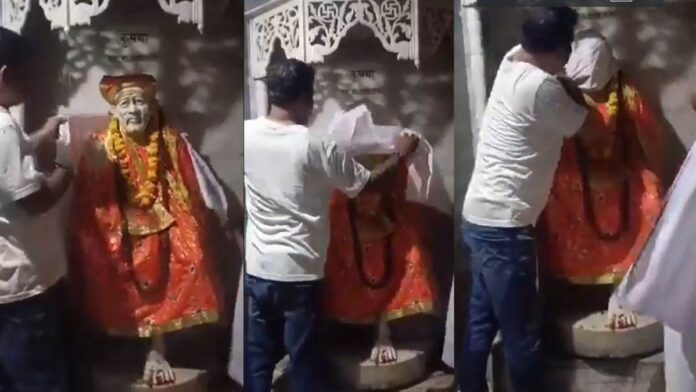The arrest of Ajay Sharma, the state unit president of Sanatan Rakshak Dal
Early on Thursday, stirred significant controversy in Varanasi. Sharma’s arrest stems from his involvement in the removal of Shirdi Sai Baba idols from at least 10 temples across the city, including the prominent Bada Ganesh temple. This incident has sparked tension between Sai Baba devotees and members of the Sanatan Rakshak Dal, leading to a larger conversation about the place of Sai Baba worship within Hindu traditions.
Ajay Sharma’s actions have been driven by his belief that the worship of Sai Baba is not sanctioned by Hindu scriptures. According to Sharma, Sai Baba, who is widely revered as a saint across India, particularly in Maharashtra and northern India, is not recognized as a deity in traditional Hindu texts. Due to what he perceives as ignorance, Sharma claims, many people have installed idols of Sai Baba in temples, which he and his organization deem inappropriate.

Sai Baba, who lived during the 19th and early 20th centuries in Shirdi, Maharashtra, is often considered an embodiment of religious tolerance and inclusivity, preaching unity between Hindu and Muslim communities. His teachings emphasized the values of love, charity, and devotion to God, transcending the boundaries of caste, religion, and sect. As a result, Sai Baba has amassed a vast following, with temples dedicated to him across India and the world.
Despite Sai Baba’s widespread popularity, his place within the Hindu pantheon has been a matter of debate for some conservative Hindu groups, such as the Sanatan Rakshak Dal. These groups argue that Sai Baba, being a mortal saint and not a divine figure described in Hindu scriptures like the Vedas or the Puranas, should not be worshipped in the same way as traditional Hindu gods and goddesses. This belief has fueled the Sanatan Rakshak Dal’s campaign to remove Sai Baba’s idols from temples, particularly in Varanasi, a city considered one of the holiest sites in Hinduism.

Sharma’s arrest followed a complaint filed by Abhishek Kumar, a devotee of Sai Baba, at the Sigra police station in Varanasi. The complaint was lodged under several sections of the Bharatiya Nyay Sanhita (Indian Penal Code), including Sections 333, 299, 298, 353(2), and 196, which deal with causing harm, religious offenses, and disturbing public peace. Police have been investigating the matter, and Sharma was taken into custody as a result of this complaint.
In response to these developments, members of the Sai Baba Devotees Association, led by prominent devotees like Mahant Vinod Kumar Pandey of the Sonarpura Sai temple, Rajneesh Kanaujia from Loha Mandi, and Dr. Akhilesh Singh from Nadesar, met with the Varanasi commissioner of police, Mohit Agarwal. They submitted a formal memorandum, demanding protection for the 72 Sai Baba temples across Varanasi. These devotees expressed deep concern over the escalating tensions and the potential for further incidents that could disturb the city’s law and order.
The devotees urged the police administration to deploy security guards at these temples to prevent any future acts of idol removal or desecration. Their demand reflects the broader sentiment of distress among Sai Baba’s followers, who feel that their religious freedom and right to worship are under attack. The submission of the memorandum was accompanied by a public statement expressing the sadness and disappointment felt by Sai Baba devotees in the wake of these incidents.
The controversy gained traction earlier in the week when members of the Sanatan Rakshak Dal removed Sai Baba’s idol from the Bada Ganesh temple in Varanasi. This temple is one of the most well-known in the city, and the removal of the idol was a highly symbolic gesture. According to reports, the Dal members arrived at the temple on Sunday, wrapped Sai Baba’s idol in a cloth, and placed it outside the temple premises. This act was meant to signal the organization’s disapproval of Sai Baba’s veneration in traditional Hindu temples.
Mahant Rammu Guru, the head priest of the Bada Ganesh temple, stated that Sai Baba had been worshipped at the temple for years due to a lack of awareness regarding scriptural guidelines. However, Ajay Sharma and his associates argue that their campaign is not about disrespecting Sai Baba’s legacy but about adhering to what they believe are the correct practices as outlined in Hindu religious texts.
Ajay Sharma, speaking after the removal of the idol, reaffirmed his stance, stating, “Keeping in mind the sentiments of the devotees, a campaign is being run to remove Sai’s statue from the temples of the city.” According to him, this movement is intended to align the religious practices in these temples with what he and his group consider to be orthodox Hinduism.
While the Sanatan Rakshak Dal’s actions have been met with outrage from Sai Baba devotees, some Hindu religious leaders have supported the campaign. Mahant Shankar Puri, the head of the Annapurna temple in Varanasi, stated that there is no mention of Sai Baba’s worship in Hindu scriptures. He echoed Sharma’s sentiments, arguing that the installation of Sai Baba’s idol in temples is a relatively recent phenomenon, driven more by popular devotion than by scriptural authority. As such, he believes the idols should be removed to maintain the sanctity of Hindu temples.
The removal of Sai Baba’s idols from temples in Varanasi has sparked a heated debate that goes beyond religious practices to touch on issues of tradition, modernity, and the role of saints in the Hindu faith. While conservative groups like the Sanatan Rakshak Dal view their campaign as a necessary step to preserve the purity of Hindu worship, many devotees of Sai Baba see it as an attack on their religious freedom. As this controversy unfolds, it highlights the ongoing tensions within Indian society over the interpretation of religious traditions and the role of reform movements in shaping contemporary Hinduism.

